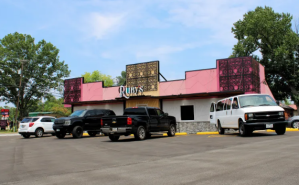More than $2.5B in roadway projects planned across East Texas
Published 5:40 am Friday, March 21, 2025

- Mark Robinson, right, introduces panel members during a State of the Region panel discussion Thursday at the Infinity Center. (Les Hassell/Longview News-Journal Photo)
More than $2.5 billion in road improvement projects are planned for Smith, Gregg and Van Zandt counties, a Texas Department of Transportation engineer told area leaders during a Thursday luncheon in Longview.
Meanwhile, county officials say they’re working to protect water supplies and advocating for high-speed rail to zip into the region.
Trending
Those were the main topics of discussion during Thursday’s State of the Region event at the Infinity Event Center. Gregg County Judge Bill Stoudt, Smith County Judge Neal Franklin, Harrison County Judge Chad Sims and Marion County Judge Leward LaFleur took part in the discussion.
Road improvements
East Texans can expect to see significant roadwork in the next several years.
TxDOT will spend roughly $40 million to replace the bridges spanning the Sabine River on Interstate 20 beginning in November, said Vernon Webb, a district engineer with the department’s Tyler district.
TxDOT will rebuild the I-20, U.S. 259 and Texas 31 interchange beginning in January 2026. The $270 million project will be the largest project in the department’s Tyler district to date, Webb said. The project will be called the “high three” because left exits will be replaced with a flyover and connectors, similar to the “high five” setup in Dallas.
I-20 through the region will eventually be widened to six lanes. Beginning in 2031, the interstate will be expanded to six lanes from the Smith County line to Texas 31, a $410 million project, Webb said. The interstate will be expanded from Texas 31 to the Harrison County line in the future, though no date has been set for the project, which will cost roughly $455 million. No date has been set for six-lane expansion of the interstate in Smith County, which will cost $1 billion.
Trending
Funding hasn’t been allocated for the I-20 widening projects, and the dates are projections, Webb said.
Texas 31 will be expanded to four lanes from the Gregg County line to CR 236 in 2029, a roughly $125 million project. It’ll be expanded from Loop 323 in Tyler to CR 236 in 2030, a roughly $220 million project, and from the Smith County line to Kilgore in 2030, a $64 million project.
Those projects arrive as motor vehicle traffic has increased in the area. In 2013, roughly 36,000 cars per day were traveling roads in Van Zandt County, 32,000 in Smith County and 32,000 in Gregg County. In 2023, there were roughly 50,000 cars on the road per day in Van Zandt County, 45,000 in Smith County and 41,000 in Gregg County.
By 2050, the department projects that 86,000 cars will be on the road each day in Van Zandt County, 67,000 in Smith County and 65,000 in Gregg County.
Water rights
LaFleur and fellow county judges said they’re opposed to a controversial proposal to sell water from Lake O’ the Pines, a main regional water supply, to the North Texas Municipal Water District, which serves the Dallas-Fort Worth area. News of the deal broke earlier this year, and some elected officials and residents have voiced opposition to it, saying it could damage that lake and the downstream Caddo Lake.
LaFleur said Dallas-area residents should build their own lake to provide for their water needs, which East Texans did with Lake O’ the Pines in the 1950s.
“They don’t want to do it because a skyscraper makes more money for their community, as far as taxing, than them building a lake,” LaFleur said.
High-speed rail
East Texas leaders have been working for years to bring high-speed rail to the region along the I-20 corridor. A proposed high-speed rail service connecting Atlanta to Dallas would follow the existing passenger rail route through Longview to Mineola and on to Dallas.
LaFleur is chairman of the rural transportation planning board for the East Texas Council of Governments, a consortium of county officials and organizations from across the region, and said most local officials are “on board” with the project.
But bringing high-speed rail to the region will require significant, costly upgrades along the rail line and will be subject to various regulatory approvals. As a result, the project is at a standstill.
“The more transportation you have in the community, the better off we are attracting industry,” LaFleur said.
He said local officials need the support of Gov. Greg Abbott to help move the project along.
Stoudt emphasized that the counties must work together to help the project stay on track.
“When you have a population that represents over a million people, that makes a difference. People listen,” he said.







